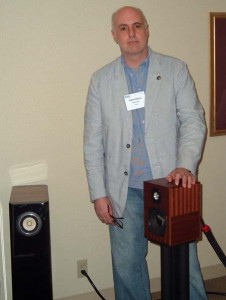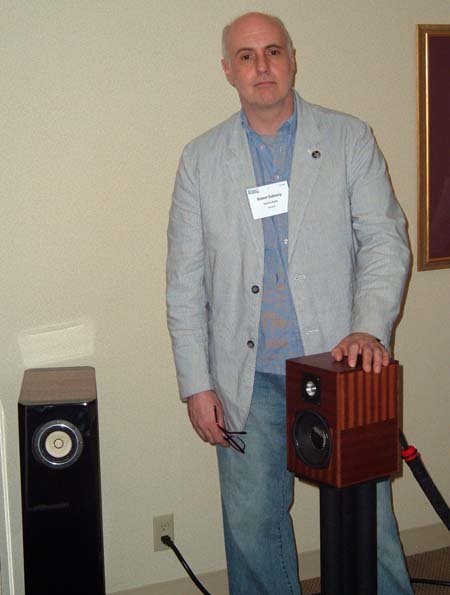HFR – What are the difficulties associated with using full range drivers?
RG – A full range driver is a balancing act between extreme low mass (low inertia) for high frequencies and sufficient mass to getthe cone large and stiff enough to produce lower frequencies (by moving a larger amount of air) without break-up. It is up to the designer to design an enclosure that will raise bass level to hopefully match the rising high frequency output.
HFR – How does the bass augmentation board affect the output of the rear horn?
RG – A horn is an acoustical device that raises efficiency (a kind of transformer if you will) within a certain bandwich. The board closes the mouth so that the built up pressure has nowhere to go. The vent (or hole) allows low frequency pressure to escape in a “distilled” form, by pushing (and pumping) the air inside the vent. In layman term, a “bass turbo compressor”. In the First Horn, our goal was bass output one octave below resonant frequency, which we achieved.
HFR – I understand that the bass augmentation plates led to the development of the VFlex loading system. Can you explain how the VFlex is different from the bass augmentation plates?
 RG – The VFlex is a “bass turbo compressor” with increased pressure, with a design goal of flat output to 2 octaves below resonant frequency. Just like a turbo engine in a car, the motor assembly needs to be strong enough to endure the added pressure, heat and torque. In the VFlex enclosure, tremendous pressure is built at both extremities of the enclosure. High out-of-phase pressure behind the cone to restrict movement (when the cone wants to move out, it is “sucked in” by pressure and vice versa) AND high in-phase pressure at the port. The air pressure is amplified by the hornlike section resulting in much greater port pressure and driver loading than a comparable bass reflex enclosure.
RG – The VFlex is a “bass turbo compressor” with increased pressure, with a design goal of flat output to 2 octaves below resonant frequency. Just like a turbo engine in a car, the motor assembly needs to be strong enough to endure the added pressure, heat and torque. In the VFlex enclosure, tremendous pressure is built at both extremities of the enclosure. High out-of-phase pressure behind the cone to restrict movement (when the cone wants to move out, it is “sucked in” by pressure and vice versa) AND high in-phase pressure at the port. The air pressure is amplified by the hornlike section resulting in much greater port pressure and driver loading than a comparable bass reflex enclosure.
For the VFlex architecture to work, the whole driver/enclosure system must be carefully optimized and works only with a precise driver Q factor. The enclosure needs to be stronger than a regular reflex enclosure and extra care must be taken in the use and placement of stiffening panels. The tuning must be perfect. For example, if the cone is not supported by air pressure in perfect sync, the driver destroys itself.
Building is long and costly, and unfortunately we just can’t design and build a “budget” version. The assembly can’t be automated and must entirely be done by hand. As a result, it can only be available through selected dealers under the Gemme Audio brand.
For example, we measured 16Hz at minus 10 dB in anechoic chamber out of a Fostex FE108Sigma mounted in a VFlex enclosure (Vivace). In typical in-room situation, this would translate in 16Hz flat. When considering that the Sigma cone is a little less than 3 inches in diameter with a resonant frequency of 77Hz, this kind of bass output is simply unbelievable and must be experienced.
HFR – There have been several different designs of rear loaded horns that have been developed over the years. Does the First Horn draw upon any of these previous designs? What is unique about how this speaker has been implemented?
RG – Sure. I penned probably 50 or 60 different horn designs over the years. When I was in college, I started a small business that built large horn loaded enclosures fro PA use (live shows, discos, etc.). All my friends (in various rock and roll bands) didn’t have enough money to buy “real” JBL scoops, so I designed and built sound equipment using cheaper Peavy drivers and had a way to earn some money while having fun.
The First Horn is built on this experience. A well known editor from an Internet audiozine wrote me a nasty letter stating that the First Horn was too simple in construction, and with too few bends to be of any use, so it was stamped as a bad product. It’s a simple fact that the ideal horn is the one with no bends. As you underlined, the First Horn has only one bend, and that the slanted shape of the speaker was designed from the start to provide an almost perfectly straight expansion shape, and that the stiffeners are used to create an exponential profile within the path. It’s easy to built a complex horn and much more difficult to design and build a simple one. We choose to make something simple, something that people could buy easily to get a taste of a horn loaded, efficient, speaker at a fraction of the cost of a conventional and complex horn. So far, I didn’t see any First Horn listed on Audiogon or eBay, so it must not be that bad 🙂
